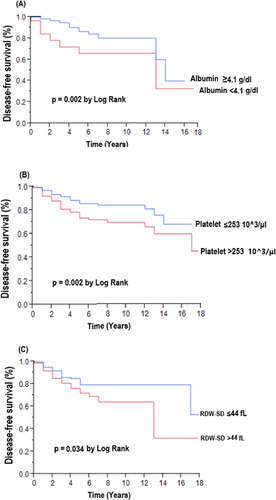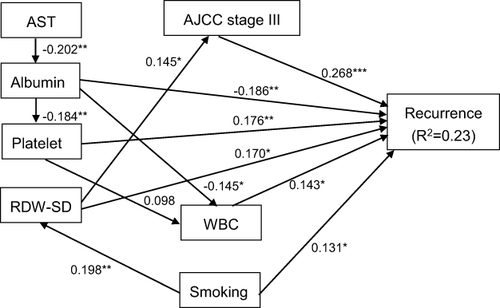Figures & data
Table 1 Descriptive Baseline Characteristics of the Study Participants by Disease Recurrence Status
Table 2 Descriptive Baseline Biochemical Data at Primary Diagnosis of the Study Participants by Disease Recurrence Status
Table 3 Cox Proportional Hazard Model of Baseline Clinical Risk Factors for Breast Cancer Recurrence in the Whole Cohort
Table 4 Cox Proportional Hazard Model of Baseline Biochemical Risk Factors for Breast Cancer Recurrence in the Whole Cohort
Figure 1 Receiver operating characteristic (ROC) curves of albumin, platelet, and RDW-SD to detect the risk of disease recurrence. A threshold value of <4.1 g/dl was associated with the risk of disease recurrence with a sensitivity of 55.9% and specificity of 24.5% for albumin (A). A threshold value of >253 10^3/μL was associated with the risk of disease recurrence with a sensitivity of 65.5% and specificity of 48.1% for platelet (B). A threshold value of >44 fL was associated with the risk of disease recurrence with a sensitivity of 36.6% and specificity of 21.7% for red cell distribution width-standard deviation (RDW-SD) (C).

Figure 2 Comparison of disease-free survival between albumin <4.1 g/dl group and albumin ≥4.1 g/dl group (A), platelet >253 10^3/μL group and platelet ≤253 10^3/μL group (B), and red cell distribution width-standard deviation (RDW-SD) >44 fL group and RDW-SD ≤44 fL group (C) in patients with breast cancer.

Figure 3 Structural equation model for disease recurrence in patients with breast cancer. Comparative fit index (CFI), 1.000; goodness of fit index (GFI), 0.980; root mean square error of approximation (RMSEA), 0.000; standardized root mean square residual (SRMR), 0.049. *p<0.05, **p<0.01, and ***p<0.001. Path loadings are standardized coefficients. Abbreviations: AST, aspartate aminotransferase; WBC, white blood cell; RDW-SD, red cell distribution width-standard deviation; AJCC, American Joint Committee on Cancer.

